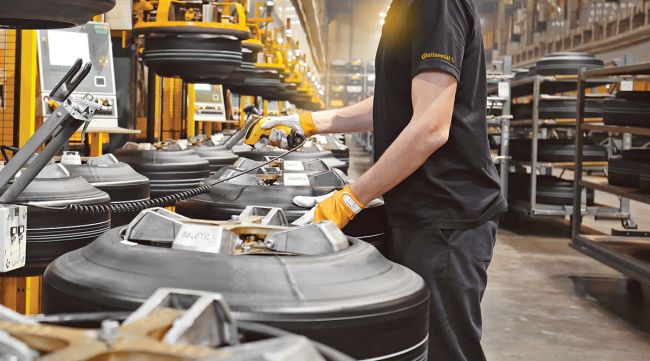Tires in production at a Continental Tire manufacturing plant. The company revised its overall sales guidance for all of 2023 to around $45.56 billion to $48.85 billion from $46.11 billion to $49.4 billion. (Continental)
Weaker-than-expected North American and European commercial vehicle replacement tire sales in the second quarter of 2023 and through the remainder of the year forced Continental to cut revenue guidance for its tire unit and the company as a whole.
North American commercial vehicle replacement tire sales fell 15% year-over-year in the most recent three-month period, the company said Aug. 9, and full-year sales are expected to be between 8% and 10% lower, compared with previous expectations of a 2% to 5% decrease.
Continental’s European commercial vehicle replacement tire sales duplicated the weakness across the Atlantic, also falling 15% year-over-year in the second quarter. For the full-year period, the company now expects European commercial vehicle tire sales to decline by between 6% and 8%, compared with previous guidance of between a 1% decrease and a 2% increase.
Consequently, revenues for the full-year period at Continental’s tires segment are expected to total $15.37 billion to $16.47 billion, not the $15.92 billion to $17.02 billion previously forecast, the company said in a presentation accompanying its second-quarter earnings.
The company also revised its overall sales guidance for all of 2023 to around $45.56 billion to $48.85 billion from $46.11 billion to $49.4 billion previously. Continental reports its earnings and guidance in euros.
Continental’s net income in the second quarter of 2023 totaled $229.45 million, compared with a loss of $275.57 million in the year-earlier period due to geopolitical and supply chain factors.
Continental’s consolidated sales totaled $11.42 billion in the most recent quarter, compared with $10.32 billion in the year earlier-quarter, an increase of 10.4%.

The Continental Tire exhibit at a 2023 industry event. Revenue at Continental’s Tires unit increased in the second quarter despite the slump in replacement sales, rising 2.3% year-on-year to $3.84 billion. (John Sommers II for Transport Topics)
A large part of the increase in the company’s overall revenue was a 19% jump in sales at its Automotive segment to $5.6 billion in the second quarter from $4.72 billion a year earlier, which it said was underpinned by a 16% increase in global automotive production.
Continental’s Automotive unit produces technology for passive safety, brake, chassis, motion and motion control systems, and now includes the German company’s autonomous driving heavy-duty trucking partnership with Aurora.
Aurora and Continental plan to introduce mass market autonomous trucking systems in 2027, and their first market will be the United States.

Host Michael Freeze clarifies the differences between predictive and preventive maintenance. He gives fresh commentary on everything from how enhanced connectivity boosts your preventive maintenance plans to what predictive possibilities AI can offer your shop. Tune in above or by going to RoadSigns.ttnews.com.
Revenue at Continental’s Tires unit increased in the second quarter despite the slump in replacement sales, rising 2.3% year-on-year to $3.84 billion from $3.73 billion a year earlier. Part of that resulted from a 7% year-on-year increase in North American commercial vehicle production, it noted.
Continental expects North American commercial vehicle production to be more robust through the remainder of 2023 too. The company now sees commercial vehicle production across the continent rising by 3%-7% year-on-year in 2023, compared with earlier expectations of a 2% decline to a 2% increase.
Results in the most recent quarter at the Tires unit were also helped by the price mix achieved even as replacement sales disappointed, Chief Financial Officer Katja Dürrfeld said during the company’s earnings call.
Dürrfeld said prices remained very strong in the premium sector and that a further boost would come from price escalators with original equipment manufacturers kicking in during the second half of 2023.
There would be no price cuts despite the expected decline in replacement sales through the rest of the year, she said in response to an analyst’s question on the call.
Some dealers are hoping for price reductions, said the CFO, while already holding high inventories. Restocking is taking place later in the year than was the case historically as a result of the inventory levels and price expectations, she added.






